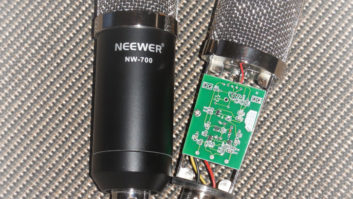One thing I have noticed in my semi-retirement is that my active colleagues in radio reporting are doing much more than getting great actualities and giving them proper context within a time constraint. Oh, yes, that still happens, but now, reporters may be called on to snap a smartphone picture or shoot a video clip for their outlet’s website and social media portals as well.
Some reporters depend exclusively on smartphones for recording and transmitting their submissions. The rest think about the smartphone (iOS or Android variety) as a backup. Like any recorder, the onboard microphone on a smartphone does a mostly passable job of recording audio. That’s OK in a pinch, but listeners and viewers (not to mention the editors, news directors and webmasters) are expecting a little more. That little more, for me, comes in the form of a shotgun microphone for a smartphone.

Paul’s smartphone with the Audio-Technica 9913 iS mounted. LITTLE SHOT
Audio-Technica has developed a monaural shotgun microphone for iOS and Android devices called the 9913 iS. It has the proper pin-outs for a smartphone headphone/microphone jack, and has a jack into which you can plug in stereo headphones of the 3.5 mm (1/8-inch) variety. It works well with both of the audio recording apps on my Galaxy S4, Audio Evolution Mobile and Lexis Audio Editor.
As with any device, a little time spent fine-tuning audio recording parameters in practice will bring better results when a recording is made on a smartphone in a newsgathering situation. So a reporter in an interview/scrum opportunity with a newsmaker can simply attach the 9913 iS, point it toward the newsmaker, hit record and record audio. That will also work for videos (as in a classic “talking head” closeup of the newsmaker) and other video applications. So if the interview/scrum was, let’s say 10 minutes long, one could select audio from the appropriate portion of the video for the upcoming newscasts, and then post the entire video to the website.
This is not a new thing; back in the day when more radio and TV stations shared ownership, newsrooms and news gathering resources, it happened quite a bit.
I use the 9913 iS to narrate short vehicle walk-around videos and broadcast them from my Periscope video account as well as a backup in case I should find myself in a news gathering situation, and need to record quality audio with my smartphone. You’ll have to enter 9913 iS in your favorite browser. As of this writing, Audio-Technica was still deciding whether to bring this microphone to the U.S. market.
One thing I remember as a reporter: Many times I had much more information than what could be included in a regular report, and that I wanted to get that information out. How could I solve that conundrum?
SoundCloud was founded in 2008 by Alex Ljung (founder and CEO) and Eric Wahlfross (founder and CTO). Its ability to share sounds between creators and listeners, and its podcasting feature works to solve that problem. SoundCloud gives a reporter or program producer the ability to publish a podcast, without having to write the XML files necessary for a podcast, simply by uploading files to the creator’s page at the SoundCloud website. If one has a Facebook, Twitter or Google account, the service integrates seamlessly.

Getting started with SoundCloud. All one needs to establish an account is a valid email address. There are three types of account: The Partner account is free, and gives the user three hours of upload time, and basic statistics on listeners. A Pro Account ($6/month, $55 per year) allows users to upload six hours and get enhanced statistics. A Pro Unlimited Account ($15/month, $135 per year) gives unlimited uploads up to 30 hours per week. There’s also an exclusive Premier Partner level that is available by invitation. One can access accounts via their app, which is available for iOS and Android devices and by logging in at soundcloud.com.
I upload my “Radio-Road-Test” program to SoundCloud (soundcloud.com/radioroadtest) as another distribution channel. The creator upload page gives options to alert Facebook, Twitter and Google followers when a new piece of audio is uploaded to the account. I upload MP3 files; SoundCloud also supports AIFF, WAV, FLAC, ALAC, OGG, MP2, AAC, AMR, and WMA files. The maximum file size is 5 GB. Good descriptive hashtags will help people find your submission when uploading the audio. SoundCloud is particular about uploading copyrighted material; they will ask you to certify that you own the copyright to the material.
The SoundCloud smartphone app allows you to record via the smartphone (see where the shotgun mic can help?) with basic cut editing functions and then post that recording to your account. By using a laptop, for instance, one can select a preproduced MP3 file, and upload it quickly. SoundCloud has a detailed podcasting creator guide (https://on.soundcloud.com/creator-guide/podcasting) that will walk a user through the process of creating a podcast from uploaded SoundCloud files. It has much more information on best practices and how to get the best benefit from SoundCloud.
But wait, there’s more: I’m experimenting with the recently released Periscope video app. As I discover tips, tricks and what to avoid, I will share those with you in a future column.
Find past columns at the Road Warrior tab under Columns at radioworld.com.
Paul Kaminski is a long time contributor, semiretired radio reporter and host of msrpk.com’s “Radio-Road-Test” (his “full-time part-time” job). Tweet @msrpk_com, follow him on Periscope and look for him on SoundCloud (radioroadtest).












